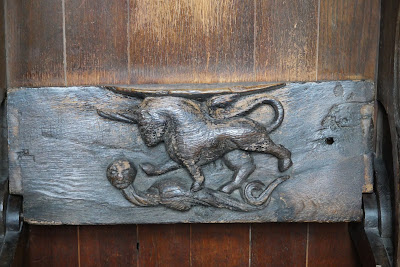We have just arrived in Durham for a weekend break and naturally we are heading straight out to see the Cathedral and the Castle. We cross Elvet Bridge and turn left into Saddler Street, then right into Owengate where we pop into the Heritage Centre to buy tickets for the Castle tour (the only way you can see the Castle). We emerge into the large Palace Green. The cathedral is ahead, sideways on. The buildings on both sides are all part of the University. I will just pick out a couple.
The first building in the left range is Cosin's Hall. It looks Georgian, but actually dates from the 1690s. It became the University's first student residence in 1833-6 and now houses the Institute of Advanced Study.
To the right of Cosin's Hall is a former Almshouse, now a café.
The Cathedral was started in 1093 to be the shrine of St Cuthbert and largely completed by 1133. Chapels were added at either end in the 12th and 13th centuries to accommodate increasing numbers of pilgrims visiting the shrine. The central tower was rebuilt in the 15th century after being struck by lightning and the spires which had been on the western towers were removed during the Civil War in the 17th century.
We entered via the Galilee chapel at the west end and what a marvelous structure it was. It is a veritable feast of Norman arches with dog tooth mouldings on them. The chapel was built to house the tomb of the Venerable Bede, known as the Father of English History for his Ecclesiological History of the English People completed in 731.
Then you go through into the nave where there are massive round columns with chevron and other patterns flanked by an aisle on either side. Above there is a gallery and a clerestory, capped by a rib-vaulted stone vault. This is Norman architecture at its finest. But the nave also contains the first use of pointed arches in England and thereby paved the way for Gothic architecture.
The magnificent rose window dominates the view ahead. It dates only from the late nineteenth century, and depicts Christ surrounded by the apostles, in turn surrounded by the 24 elders from the book of Revelation
In the South Transept there is a wonderful clock: it was installed between 1494-1519, and renovated between 1620 and 1638 and is known as Prior Castell's Clock
On the side of the Quire was the astonishing tomb of Thomas Hatfield.
Behind the Quire is the tomb of St Cuthbert, although there is not much to see. Returning to the south Transept you find the entrance to the large medieval Cloister.
Now we headed off to our guided tour of the Castle. It is part of the University and has been so since its founding in 1832. I wondered what there would be to see, but I was to be greatly surprised.
Construction of the Castle began in 1072 under the orders of William the Conqueror. The construction took place under the supervision of the Earl of Northumberland, Waltheof, until he rebelled against William and was executed in 1076. The castle then came under the control of Walcher, the Bishop of Durham. He purchased the earldom and thus became the first of the celbrated Prince-Bishops of Durham, a title that was to remain until the 19th century, and was to give Durham a unique status in England.
Construction of the Castle began in 1072 under the orders of William the Conqueror. The construction took place under the supervision of the Earl of Northumberland, Waltheof, until he rebelled against William and was executed in 1076. The castle then came under the control of Walcher, the Bishop of Durham. He purchased the earldom and thus became the first of the celbrated Prince-Bishops of Durham, a title that was to remain until the 19th century, and was to give Durham a unique status in England.
You enter through the imposing gatehouse, built by Hugh de Puiset ...
... and emerge into an unevenly shaped courtyard. On the left is the Great Hall of 1300 …
... and emerge into an unevenly shaped courtyard. On the left is the Great Hall of 1300 …
… and in front are two other ranges.
What remains of the Norman keep is off to the right (seen here from Palace Green) – it was largely rebuilt in Victorian times.
The Great Hall was suitably massive and housed a number of students diligently working singly or in groups at long tables. Soon we had our first big surprise: an ancient Norman doorway, of a style I have never seen before. Our Guide told us that it was one of the main reasons why Durham has World Heritage Site status.
The Great Hall was suitably massive and housed a number of students diligently working singly or in groups at long tables. Soon we had our first big surprise: an ancient Norman doorway, of a style I have never seen before. Our Guide told us that it was one of the main reasons why Durham has World Heritage Site status.
We next saw the small Victorian chapel with one rather lovely misericord of a unicorn killing a snake.
And then for possibly the best bit: underground to the old chapel, dating back to 1200.
















1 comment:
Hello,
I’m working on a book based on my old PhD about the image of the unicorn, and I was thinking of adding a small chapter on misericords. Could it be possible to use your image of the unicorn / snake misericord. It’s interesting because while the unicorn as an enemy of the snake was popular, it usually makes the snake flee. I have very few images of a unicorn trampling a serpent.
Best
Bruno Faidutti
Post a Comment